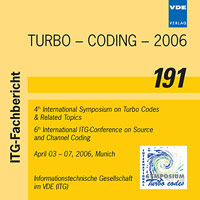Connecting Belief Propagation with Maximum Likelihood Detection
Conference: TURBO - CODING - 2006 - 4th International Symposium on Turbo Codes & Related Topics; 6th International ITG-Conference on Source and Channel Coding
04/03/2006 - 04/07/2006 at Munich, Germany
Proceedings: TURBO - CODING - 2006
Pages: 6Language: englishTyp: PDF
Personal VDE Members are entitled to a 10% discount on this title
Authors:
Walsh, John MacLaren (School of Electrical and Computer Engineering, Cornell University, Ithaca, NY, USA)
Regalia, Phillip Allan (Department of Electrical Engineering and Computer Science, Catholic University of America, Washington DC, USA)
Abstract:
While its performance in the Gaussian, infinite block length, and loopless factor graph cases are well understood, the breakthrough applications of the belief propagation algorithm to the decoding of turbo and LDPC codes involve finite block lengths, finite alphabets, and factor graphs with loops. It has been shown in these instances that the stationary points of the belief propagation decoder are the critical points of the Bethe approximation to the free energy. However, this connection does not clearly explain why the stationary points of belief propagation yield good performance, since the approximation is not in general exact when there are loops in the graph. We introduce an alternate constrained maximum likelihood optimization problem here which analytically connects the stationary points of belief propagation with the maximum likelihood sequence detector.


